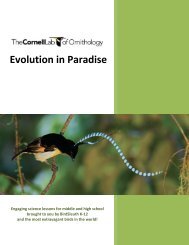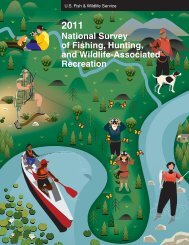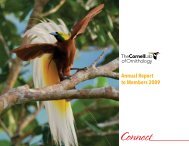AnnuAl RepoRt to membeRs | 2012 - Cornell Lab of Ornithology
AnnuAl RepoRt to membeRs | 2012 - Cornell Lab of Ornithology
AnnuAl RepoRt to membeRs | 2012 - Cornell Lab of Ornithology
You also want an ePaper? Increase the reach of your titles
YUMPU automatically turns print PDFs into web optimized ePapers that Google loves.
Technology:Gathering the DataThe power <strong>of</strong> birders and technologyFifteen years ago, programmers at the <strong>Cornell</strong> <strong>Lab</strong> harnessed the power <strong>of</strong>the Internet <strong>to</strong> launch the world’s first online citizen-science project—the Great Backyard Bird Count. Ever since, they’ve continued <strong>to</strong> innovatenew ways <strong>to</strong> engage birders in gathering, sharing, and exploring massiveamounts <strong>of</strong> data for science and conservation. This year, a revolutionary newapp called BirdLog enabled birders <strong>to</strong> upload their sightings from the fieldin real-time from iPhones and Androids. As bird observations submitted <strong>to</strong>eBird surpassed the 100 million mark this year, scientists made huge stridesin mining the data <strong>to</strong> reveal new insights about bird migration.Sensors for the Night skyFor millennia, humans have heard the fleeting sounds <strong>of</strong> birds migrating atnight, but only in recent years have technological breakthroughs made it possible<strong>to</strong> reveal the details at many locations, night after night. By modifyingau<strong>to</strong>nomous recording units (ARUs) initially developed <strong>to</strong> listen <strong>to</strong> whalesin the ocean, <strong>Cornell</strong> <strong>Lab</strong> engineers have created terrestrial ARUs that havecaptured nearly 18 terabytes <strong>of</strong> sound data from the night sky. These recordingsreveal millions <strong>of</strong> birds that utilize travel corridors, including those thatfly over an area overnight and are never seen. Someday, birders might helptrack nocturnal migration across the continent by mounting ARU-type unitson their ro<strong>of</strong><strong>to</strong>ps.Chestnut-sided Warblers fly across the Gulf <strong>of</strong> Mexico on theirannual migrations. New maps based on eBird data reveal that theytake different paths in spring and fall, north through the westernGulf and Texas, and south via the eastern Gulf and Florida.Night Flight ListenerAndrew Farnsworth has a rare talent: Hecan identify North American birds by earat night, and he’s driven <strong>to</strong> find out whatthose calls can tell us about migration.As a <strong>Cornell</strong> graduate student, he createdthe “Rosetta S<strong>to</strong>ne” for warblers—a catalog<strong>of</strong> flight calls for 48 species <strong>of</strong> migrantwarblers—and studied how these callsvary depending on evolutionary his<strong>to</strong>ry,weather, migration density, and otherfac<strong>to</strong>rs. Now a <strong>Lab</strong> researcher, Farnsworth’sdeeply specialized expertise is vital <strong>to</strong> <strong>Lab</strong>efforts <strong>to</strong> moni<strong>to</strong>r night flights and protectflyways for these unseen migrations.Philip MontgomeryChestnut-sided Warbler by Michael Furtman6






